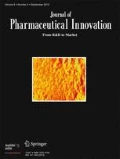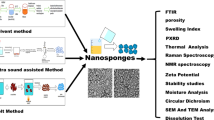Abstract
Purpose
Pramipexole (Prami) is renowned as one of the most widely used drugs in the treatment of Parkinson’s disease. This study aimed to prepare slow-release nanofibers of Prami to reduce (or control) the release rate of the drug from the formulation.
Methods
For this purpose, polyvinyl alcohol (PVA)/carboxymethylcellulose (CMC) nanofibers loaded with Prami were fabricated using the electrospinning technique and characterized using scanning electron microscopy (SEM) and infrared spectroscopy (FTIR). A test has been conducted to evaluate the swelling of the formulations and an HPLC method has been used to assess the effect of both co-electrospinning with polycaprolactone (PCL) nanofibers and cross-linking using glutaraldehyde (GA) vapors on the release kinetics.
Results
The results showed that the co-electrospun nanofibers cross-linked by 12-h exposure to GA vapor exhibited slow release compared to non-hybrid and non-cross-linked fibers. The cell viability assay using the MTT test showed that the nanofibers were cytocompatibility regarding SFIF-PI 44 cell line. The hybrid cross-linked nanofibers were placed in the gelatin shell capsule, and the dissolution profile of the drug in the capsules was investigated.
Conclusions
These results indicated that using nanofibers as the carrier encapsulated in the conventional capsule dosage form can be considered as a new formulation to reduce the used excipients and ease of production.






Similar content being viewed by others
References
De Rijk MC, Rocca W, Anderson D, Melcon M, Breteler M, Maraganore D. A population perspective on diagnostic criteria for Parkinson’s disease. Neurology. 1997;48(5):1277–81.
Balestrino R, Schapira AHV. Parkinson disease. Eur J Neurol. 2020;27(1):27–42.
Kreiss DS, Bergstrom DA, Gonzalez AM, Huang K-X, Sibley DR, Walters JR. Dopamine receptor agonist potencies for inhibition of cell firing correlate with dopamine D3 receptor binding affinities. Eur J Pharmacol. 1995;277(2–3):209–14.
Weiner W, Factor S, Jankovic J, Hauser R, Tetrud J, Waters C, et al. The long-term safety and efficacy of pramipexole in advanced Parkinson’s disease. Parkinsonism Relat Disord. 2001;7(2):115–20.
Möller JC, Oertel WH, Köster J, Pezzoli G, Provinciali L. Long-term efficacy and safety of pramipexole in advanced Parkinson’s disease: results from a European multicenter trial. Movement disorders: official journal of the Movement Disorder Society. 2005;20(5):602–10.
Danzeisen R, Schwalenstoecker B, Gillardon F, Buerger E, Krzykalla V, Klinder K, et al. Targeted antioxidative and neuroprotective properties of the dopamine agonist pramipexole and its nondopaminergic enantiomer SND919CL2x [(+) 2-amino-4, 5, 6, 7-tetrahydro-6-Lpropylamino-benzathiazole dihydrochloride]. J Pharmacol Exp Ther. 2006;316(1):189–99.
Kitamura Y, Kosaka T, Kakimura J-I, Matsuoka Y, Kohno Y, Nomura Y, et al. Protective effects of the antiparkinsonian drugs talipexole and pramipexole against 1-methyl-4-phenylpyridinium-induced apoptotic death in human neuroblastoma SH-SY5Y cells. Mol Pharmacol. 1998;54(6):1046–54.
Gu M, Irvani M, Cooper JM, King D, Jenner P, Schapira AH. Pramipexole protects against apoptotic cell death by non-dopaminergic mechanisms. J Neurochem. 2004;91(5):1075–81.
Abramova NA, Cassarino DS, Khan SM, Painter TW, Bennett JP Jr. Inhibition by R (+) or S (–) pramipexole of caspase activation and cell death induced by methylpyridinium ion or beta amyloid peptide in SH-SY5Y neuroblastoma. J Neurosci Res. 2002;67(4):494–500.
Ferrari-Toninelli G, Maccarinelli G, Uberti D, Buerger E, Memo M. Mitochondria-targeted antioxidant effects of S (-) and R (+) pramipexole. BMC Pharmacol. 2010;10(1):1–6.
Vlachou M, Kikionis S, Siamidi A, Tragou K, Kapoti S, Ioannou E, et al. Fabrication and characterization of electrospun nanofibers for the modified release of the chronobiotic hormone melatonin. Curr Drug Deliv. 2019;16(1):79–85.
Agarwal S, Wendorff JH, Greiner A. Use of electrospinning technique for biomedical applications. Polymer. 2008;49(26):5603–21.
Chakraborty S, Liao I-C, Adler A, Leong KW. Electrohydrodynamics: a facile technique to fabricate drug delivery systems. Adv Drug Deliv Rev. 2009;61(12):1043–54.
Ramakrishna S, Fujihara K, Teo W-E, Yong T, Ma Z, Ramaseshan R. Electrospun nanofibers: solving global issues. Mater Today. 2006;9(3):40–50.
El-Newehy MH, El-Naggar ME, Alotaiby S, El-Hamshary H, Moydeen M, Al-Deyab S. Preparation of biocompatible system based on electrospun CMC/PVA nanofibers as controlled release carrier of diclofenac sodium. J Macromol Sci A. 2016;53(9):566–73.
Joseph BKSV, Sabu C, Kalarikkal N, Thomas S. Cellulose nanocomposites: fabrication and biomedical applications. J Bioresour Bioproduct. 2020;5(4):223–37.
Santos C, Silva CJ, Büttel Z, Guimarães R, Pereira SB, Tamagnini P, et al. Preparation and characterization of polysaccharides/PVA blend nanofibrous membranes by electrospinning method. Carbohydr Polym. 2014;99:584–92.
Shao D, Jiang Z, Wang X, Li J, Meng Y. Plasma induced grafting carboxymethyl cellulose on multiwalled carbon nanotubes for the removal of UO22+ from aqueous solution. J Phys Chem B. 2009;113(4):860–4.
Islam MS, Karim MR. Fabrication and characterization of poly (vinyl alcohol)/alginate blend nanofibers by electrospinning method. Colloids Surf A Physicochem Eng Asp. 2010;366(1–3):135–40.
Kapahi H, Khan NM, Bhardwaj A, Mishra N. Implication of nanofibers in oral drug delivery. Curr Pharm Des. 2015;21(15):2021–36.
Wilding IR. Site-specific drug delivery in the gastrointestinal tract. Critical Reviews™ in Therapeutic Drug Carrier Systems. 2000;17(6).
Cole ET, Scott RA, Connor AL, Wilding IR, Petereit H-U, Schminke C, et al. Enteric coated HPMC capsules designed to achieve intestinal targeting. Int J Pharm. 2002;231(1):83–95.
Tort S, Han D, Steckl AJ. Self-inflating floating nanofiber membranes for controlled drug delivery. Int J Pharm. 2020;579:119164.
Rostami E, Kashanian S, Azandaryani AH. Preparation of solid lipid nanoparticles as drug carriers for levothyroxine sodium with in vitro drug delivery kinetic characterization. Mol Biol Rep. 2014;41(5):3521–7.
Alipour R, Khorshidi A, Shojaei AF, Mashayekhi F, Moghaddam MJM. Silver sulfadiazine-loaded PVA/CMC nanofibers for the treatment of wounds caused by excision. Fibers Polym. 2019;20(12):2461–9.
Allafchian A, Hosseini H, Ghoreishi SM. Electrospinning of PVA-carboxymethyl cellulose nanofibers for flufenamic acid drug delivery. Int J Biol Macromol. 2020;163:1780–6.
Venkateswarlu K, Thakur H, Babu TNB. Fabrication of extended release tablets of pramipexole: in-vitro studies. Pharm Methods. 2017;8(2).
Darbasizadeh B, Fatahi Y, Feyzi-Barnaji B, Arabi M, Motasadizadeh H, Farhadnejad H, et al. Crosslinked-polyvinyl alcohol-carboxymethyl cellulose/ZnO nanocomposite fibrous mats containing erythromycin (PVA-CMC/ZnO-EM): fabrication, characterization and in-vitro release and anti-bacterial properties. Int J Biol Macromol. 2019;141:1137–46.
Hashmi M, Ullah S, Ullah A, Saito Y, Haider M, Bie X, et al. Carboxymethyl cellulose (CMC) based electrospun composite nanofiber mats for food packaging. Polymers. 2021;13(2):302.
Dash S, Murthy PN, Nath L, Chowdhury P. Kinetic modeling on drug release from controlled drug delivery systems. Acta Pol Pharm. 2010;67(3):217–23.
Singhvi G, Singh M. Review: in vitro drug release characterization models. Int J Pharm Sci Res. 2011;2:77–84.
Fredenberg S, Wahlgren M, Reslow M, Axelsson A. The mechanisms of drug release in poly(lactic-co-glycolic acid)-based drug delivery systems–a review. Int J Pharm. 2011;415(1–2):34–52.
Liu J-Y, Zhang X-X, Huang H-Y, Lee B-J, Cui J-H, Cao Q-R. Esomeprazole magnesium enteric-coated pellet-based tablets with high acid tolerance and good compressibility. J Pharm Investig. 2018;48(3):341–50.
Kuang C, Sun Y, Li B, Fan R, Zhang J, Yao Y, et al. Preparation and evaluation of duloxetine hydrochloride enteric-coated pellets with different enteric polymers. Asian J Pharm Sci. 2017;12(3):216–26.
Funding
The authors gratefully recognize the research council of Kermanshah University of Medical Sciences [Grant Number: 4000226] for financial support.
Author information
Authors and Affiliations
Corresponding author
Ethics declarations
Conflict of Interest
The authors declare no competing interests.
Additional information
Publisher's Note
Springer Nature remains neutral with regard to jurisdictional claims in published maps and institutional affiliations.
Rights and permissions
About this article
Cite this article
Limoee, M., Allahdad, M., Samadian, H. et al. Preparation and Evaluation of Extended-Release Nanofibers Loaded with Pramipexole as a Novel Oral Drug Delivery System: Hybridization of Hydrophilic and Hydrophobic Polymers. J Pharm Innov 18, 287–299 (2023). https://doi.org/10.1007/s12247-022-09625-1
Accepted:
Published:
Issue Date:
DOI: https://doi.org/10.1007/s12247-022-09625-1




